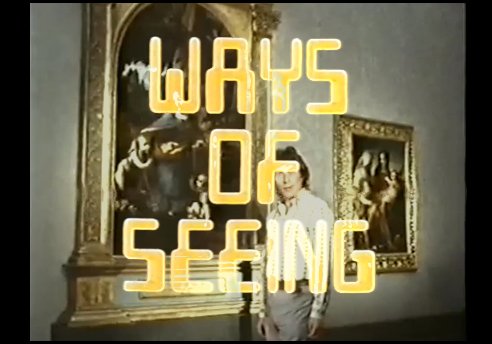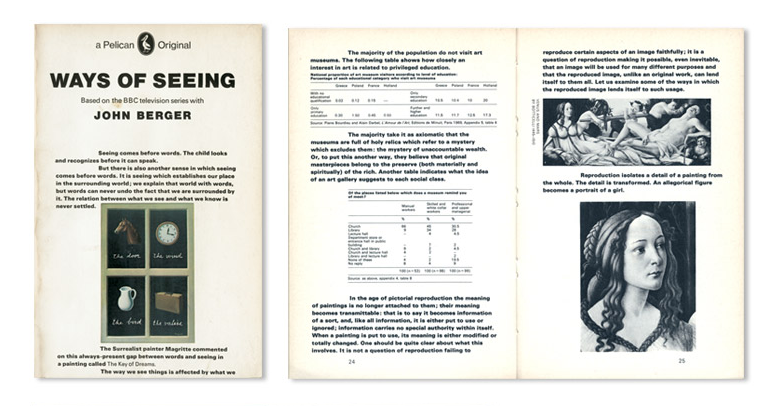ita | eng
Ways of Seeing is a short book by John Berger, in collaboration with Sven Bloomberg, Michael Dibb, Richard Hollis and Chris Fox, adapted from the 1972 BBC TV series. The book proposes to challenge conventional art criticism and change it, mainly by raising questions about hidden ideologies in visual images and exploring the idea of art as a commodity. It focuses on visual art, mainly paintings and photography – including advertising.

Ways of Seeing (1972)
The book is divided into seven chapters, or essays, four of which have both writing and images, and the other three comprise solely of images. The title of the book describes its content extremely well, it’s about exactly that: ways of seeing. As Berger puts it right from the start of the book, «Seeing comes before words. The child looks and recognises before it can speak». Seeing is fundamental, both physically and metaphorically, but seeing, as Berger explains it, is not neutral. Our ways of perception are less spontaneous than we generally assume, the way we see things is manipulated by numerous external factors and is often based on cultural conventions. «We only see what we look at. To look is an act of choice… We never look at just one thing; we are always looking at the relation between things and ourselves».
Topics, ideas, structure
There are four key ideas presented in the book. In the first essay, Berger examines the relationship between seeing and knowing, and how our assumptions affect how we see a painting. What and how we see is often mediated by culture, this culture may have its own agenda, it may obscure the plain meaning of images. Berger discusses the importance of social and historical context when looking at art: our eyes naturally look, but how we see can assume an idea, an understanding of the subject. According to Berger our private conscience can somewhat resemble a mechanical eye: the eye selects what to focus on and what to neglect, so what we see and how we see affects us and establishes our place in the world.

Ways of Seeing, Pelican Books
The role of women in art
The second essay focuses on the role of women in art. On how they are perceived, even in todays world, as objects. «To be born a woman has been to be born, within an allotted and confined space, into the keeping of men…From earliest childhood she has been taught and persuaded to survey herself continually». Berger simplifies the distinction between men and women: men act and women appear. By looking at European oil paintings, especially the category of the nude, we can discover how women have been seen and judged over time. How the women portrayed (subject/object) are usually placed in such a way as to be seen, and are aware this fact of being seen.
According to Berger there is a constant contrast within the woman: she is both the surveyor and the surveyed (whereas a man is simply the surveyor). This unequal relationship has been deeply rooted into our culture, so much so that many women still regard themselves and their femininity as men would, or as Berger puts it, «They do to themselves what men do to them». This system of gender relations is still present today in media like advertising, journalism and television where the male is still the spectator, and the female still the object.
The relationship between subject and ownership
In the third essay Berger discusses the relationship between subject and ownership, and creates an analogy between possession and the way of seeing incorporated into oil painting. Berger states that, «The art of any period tends to serve the ideological interests of the ruling class». So oil painting did to appearances what capital did to social relations: everything became exchangeable because everything became a commodity. Oil painting created a way of seeing, a system of conventions for representing the visible, showing the relation between property and art in European culture.
The last essay addresses the idea of ownership in a consumerist society, discussing the power of imagery in advertising (particularly photography). Berger discusses the impact of publicity in this modern day image culture where we are constantly bombarded with hundreds of images every day of our lives. Even if we pass by them and later forget them, for a moment these images will have stimulated the imagination by way of memory or expectation. Though publicity seems to offer free choice, in reality it is offering only one choice: «It proposes to each of us that we transform ourselves, or our lives, by buying something more». Publicity creates glamour, which in turn creates envy, envy of others, envy of the happiness portrayed in the advertisement which we can never fully grasp because it is never about the present, advertisements are always selling either the past or the future.
This short insightful book is a study of the psyche through visual culture, it goes beyond the appearance of things, and though it was written in the 70s many of its ideas are still relevant today.
Buy the book here
Read other Focus on ZìrArtmag
